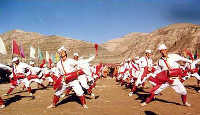| Art Q&A > Dance | กก |
|
Ansai Waist Drum Dance
The drum dance is a traditional lunar New Year and Lantern Festival activity in Shaanxi Province . Young people perform the dance throughout their villages while wishing people a happy New Year. Villagers set off firecrackers to welcome the arrival of the dancers and invite them to sample their homemade rice wine.
Decayed wooden drums covered with boa skins have been unearthed from the Yin ruins of Anyang City , Henan Province, suggesting that waist drums appeared more than 3,000 years ago. It is believed that waist drums were originally used in ancient times by Chinese soldiers stationed at the border to sound alarms, train troops or accompany cavalry (matching to the rhythm of horse hooves) as the soldiers advanced. This theory is evidenced by a concentration of waist drums in frontier fortress regions near the Great Wall , including martial costumes and other dance elements.
The
Ansai waist drum dance is an extremely impressive spectacle that consists of
vigorous dances and leaps accompanied by frenetic drumming. The dancers wear
costumes and headdresses similar to those of ancient Chinese soldiers.
|
|||||
 |

 Origin
Origin

 Ways of Performing
Ways of Performing